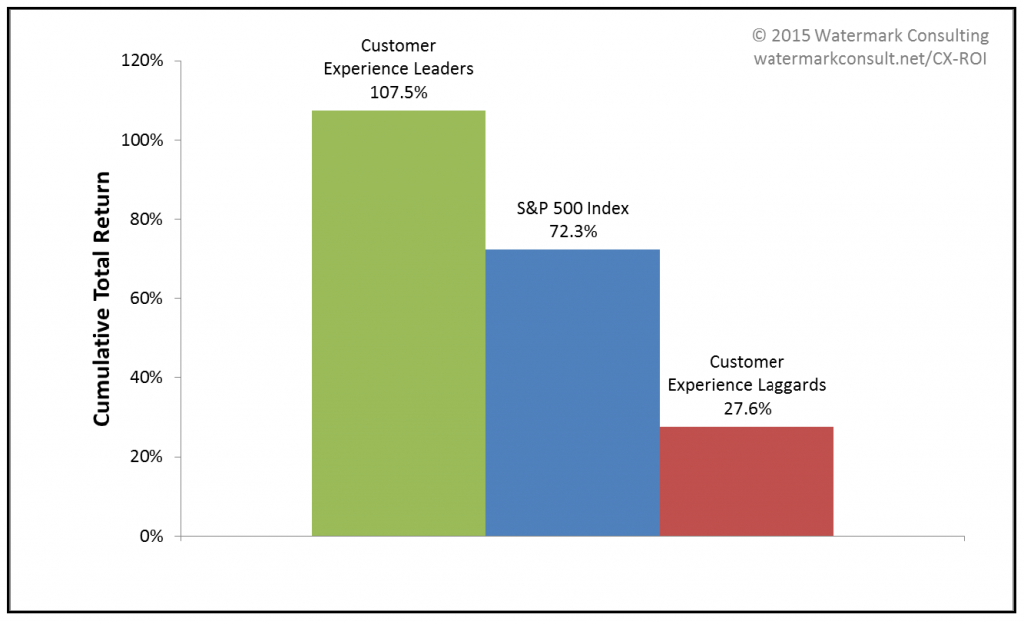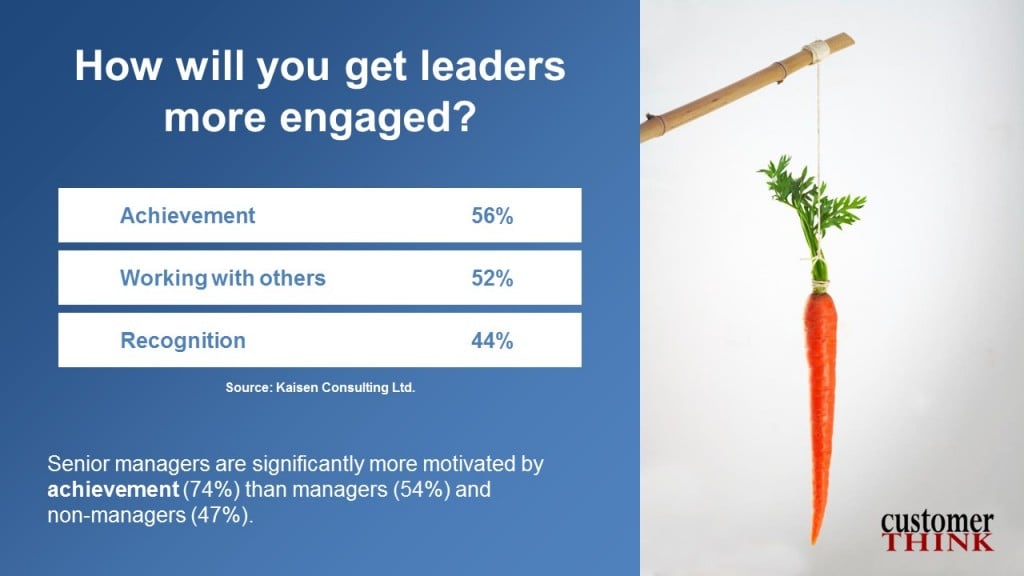These days everyone seems to be on the CX bandwagon. Various studies find that upwards of 70% of executives believe CX is the key to differentiate in a world where it’s not enough to offer a competitive product or price.
And, in recent years industry studies appear to show that firms offering great experiences out-compete those that don’t. Perhaps the most famous is this chart developed by Watermark Consulting, using data from Forrester Research.

Studies like this are great for stimulating interest in CX. This “proves,” according to this post and many others, that investing in CX will lead to better business performance.
Leaving aside for the moment whether correlation proves cause and effect (it doesn’t), the key question is whether this is enough to stimulate the kind of action CEOs need to take to turn CX dreams into reality. Most CEOs have been around the ROI block a few times, and won’t invest in something based on a general industry study. Turns out that top-performing companies do a number of things really well — so it’s easy to construct charts that show excellence in “X” is correlated with business success.
It also won’t help your case that “CX” is being used so broadly that it could mean literally anything, as I have commented in my post “Has CXM ‘Jumped the Shark,’ trying to be the Theory of Everything?”.
What CEOs want to know is how investments to improve CX (which I’ll call CX Management or CXM in this post) will translate into specific business benefits like revenue growth, increased profitability, cost savings, etc.
So I asked CXM experts: What advice do you have for CX professionals on how to convince upper management to get more personally engaged? In other words, what would motivate them to change? Is it logic or emotion? Powerpoint slides, spreadsheets, stories, or what?
1. Make Money. Save Money. Any Questions?
Given that senior executives like to get things done…

… it shouldn’t come as a surprise that touchy feely stories of customer love aren’t going to cut it in the C-Suite.
Lynn Hunsaker of Clearaction:
Money talks. And logic. Upper management may need to be reminded about the source of revenue: investors leave when customers leave, not the other way around. Earnings per share increases when profitable customers organically expand share of budget with the company. Show the % of customers retained, their revenue contribution, their purchase expansion beyond the first product they bought, their influence on other customers and prospects.
Patrick Gibbons of Walker:
Ultimately I think it must make business sense (which leans toward the “logic” side). If upper management sees that a CX project led to cost savings or revenue gains it will garner some attention. This is more persuasive than observing industry trends, monitoring Net Promoter scores, or believing it is the “right thing to do.”
Colin Shaw of Beyond Philosophy:
Most senior management are interested in cost savings, certainly when I worked at British Telecom before starting Beyond Philosophy the way I approached it was to show how improving the customer experience would save money. I’ve never worked in implementation that doesn’t save money. This gets their attention.
Denyse Drummond-Dunn of C3Centricity:
From my experience the best way is through either a test case, or through the use of the cost of not responding to customer complaints appropriately. When you can show the impact on the business, not executive will be deaf. Many FMCG companies till work with TARP’s Damage Model, since it is one of the simplest to use of any trying to model the impact of customer complaints on the business
2. Don’t Forget to Engage Emotionally
Having the right numbers is critical. But CEOs are human too, so you should also strive to get them to take CX personally.
One technique that I think can really help is to set up a Customer Room and get senior management to hold meetings there. Keep CX top of mind by including not just common metrics like NPS, churn rates and so on, but also journey maps, customer stories, social media feeds, videos and more.

Still, there’s really no substitute for actually spending time with customers, and with employees who serve customers.
Chip Bell of The Chip Bell Group:
“You can pretend to care,” wrote Tex Bender, “but you cannot pretend to be there.” The key action is to spend time with customers and with the people directly serving customers.
Ian Golding of Customer Experience Consultancy Ltd.:
Continually citing examples of Disney, Amazon et al to try and convince senior leaders to become personally engaged in CX is not an effective strategy – nor is regularly evangelising about CX and repeating theory over and over again. In my experiences, there are a number of things that CX professionals need to consider when trying to engage senior leaders – and they are not complicated. Get them to TALK about experiences of their own as consumers, and … experience the customer and employee experiences for themselves.
Erich Dietz of InMoment:
The customer must be present in all decisions and discussions, regardless if they are about product, finance, operations, marketing, HR, etc. I mean that both figuratively and literally. Not only in all internal company communications, but to the point of having leaders actually sit down with the customers that buy their products or services over a meal. Consistently humanizing the customer in the eyes of leadership and the employee base is critical to long term success.
Jeanne Bliss of CustomerBliss:
When I worked at really large companies, we’d find a leader of a country and would work with them on embedding this stuff and showing it in a more closed environment, if you will, and work it through. You go back and you can present that information, show the results and show what happened. Their people are happier. Sometimes that works, sometimes it doesn’t, but we find that when you’ve got a frustrated CCO, finding an early adopter can help.
3. Take Advantage of a Burning Platform
My final bit of advice is to, as Winston Churchill once said: “Never let a good crisis go to waste.”

A “burning platform” is a major business challenge that has the full attention of the C-Suite. If you can show how CXM investments will address market share losses, slowing revenue growth, or out-of-control service costs, chances are you’ll get an audience with those holding the purse strings.
Sprint was on the verge of going out of business in 2007 and used CX as a rallying point to finally get serious about customer service. The company saved millions of dollars while improving customer satisfaction from worst to first in the industry.
So there you have it, three ways to make your case to the CEO on why to invest in CXM. Lead with numbers, reenforce with stories, and link CXM to the solution of a big business problem. Good luck!




These are terrific. With these strategic guidelines, corporate executives can see the clear path for leading their organizations to a more focused, altruistic, values-driven, and financially successful culture by creating and sustaining optimum customer experiences.
The one thing I’d add is that all of this, including the great quotes you’ve cited, need to be baked into the enterprise DNA. As stated in one of my posts from last year: “is your company ‘human’? Does it focus on providing stakeholder benefit? Does it understand customers, and their individual journeys? Are customer experiences ‘human’ and branded? Is communication, and are marketing efforts, omni-channel, micro-segmented and even personalized? Does the company create an emotional, trust-based connection and relationships with customers, and with employees as well? If the answer to these questions is YES, then ‘being human’ becomes a reality, the value of which has been recognized for some time, and not merely a buzz-concept.”
By any yardstick or perspective a CEO cares to apply, these things can make an organization world-class.
Hi Bob
Thanks for a very thoughtful piece of anecdotal research.
In my experience the three suggestions you make to engage senior management help answer the ‘What’ (on Earth is Customer Experience?) question, but don’t really help answer the ‘So What’ (does Customer Experience mean for me?) question or the all important ‘What (do I do) Next? question.
As you quite rightly suggest, a majority of CXOs now recognise the importance of competing on the quality of their customer experiences, but they struggle to understand what that means for them in detail or what they should do, step-by-step, to develop their experiences. It is all too easy to get hung up on drawing pretty pictures like journey maps which don’t help identify the interactions that need to be developed, the decisions that need to be supported and the content that needs to be created, let alone the underlying capabilities that need to be developed to make the improvements in the experience sustainable or how the improved experience drives incremental cash-flow.
Paradoxically, perhaps the best chance for customer experience is the development of new software tools like Xerox XMPie Circle or Pega Decision Manager that, with a little bit of intelligent adaptation, can be used to design, operate and manage immersive customer experiences one interaction at a time.
Graham Hill
@grahamhill
PS. I strongly support Michael’s emphasis on companies providing a human face to customers (without necessarily having to put humans in front of the customer), but it is largely academic if the CXO gets customer experience but doesn’t know what it means nor what to do next.
Graham, you’re quite right that CEOs should know what to do next. But that assumes they agree to really invest in CXM. The ‘what to do next’ question is academic until the CEO commits real resources, not just ‘we love customers’ rhetoric.
I’m sure that some if not most of the ROI discussions around CX will include the question: What is CX?
On one end of the spectrum, CX proponents say it’s the entire value proposition — products, services, interactions, pricing, feelings — anything and everything. In that case, I suspect the CEO will question what exactly are they investing in.
At the other extreme, CX could be understood more narrowly as a VoC program or customer service improvement.
Since the industry has not settled on a precise CX definition, it’s particularly important for companies to define the scope of their CX initiative, and tie costs and benefits to that initiative.
I doubt that many CEOs will get personally involved in CX implementation like journey mapping or CX design. This is best left to the CCO or CX professionals trained in such work.
Instead of delving into the details of CX implementation, the CEO has a much more important leadership role to play: “walking the talk” to set a positive example that CX really matters. You can find some examples here.
Hi Bob
In my experience the What?, So What? and What Next? questions are all part of the initial CEx pitching process. No CEO is gong to buy in to what will likely turn into an expensive and complicated business transformation without knowing the answers to all three questions. And without knowing the answers, it is unlikely they the CEO will be able to walk the talk.
Don’t under estimate the power of journey maps. In a corporate world full of ‘death by powerpoint’ slide packs created by inwardly-facing consultants, having an A0 roll setting out the customer’s journey in full colour, complete with verbatims and customer videos, is a powerful way to get the customer experience message across.
Graham Hill
@grahamhill
Great post, Bob! I believe that in order to convince someone (especially top management) you need to lay out an entire plan of action/strategy and convince them on how it will prove to beneficial for the organization in the long haul. If one goes about and follows the points you have mentioned in your post I’m sure anyone would see the logic behind adopting CX management.